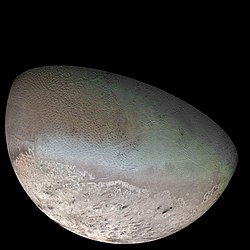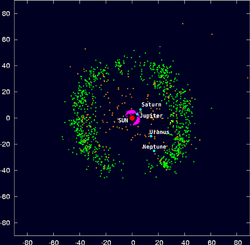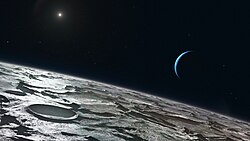PIA01538 Complex Geologic History of Triton
Formát:
1885 x 1903 Pixel (462483 Bytes)
Popis:
NASA's original caption: "Part of the complex geologic history of icy Triton, Neptune's largest satellite, is shown in this Voyager 2 photo, which has a resolution of 900 meters (2,700 feet) per picture element. The photo was received as part of a Triton-mapping sequence between 3:30 and 5:30 a.m. (PDT). This view is about 500 kilometers (300 miles) across. It encompasses two depressions, possibly old impact basins, that have been extensively modified by flooding, melting, faulting, and collapse. Several episodes of filling and partial removal of material appear to have occurred. The rough area in the middle of the bottom depression probably marks the most recent eruption of material. Only a few impact craters dot the area, which shows the dominance of internally driven geologic processes on Triton."
The image shows two of Triton's cryovolcanic "walled plains", Tuonela Planitia (left) and Ruach Planitia (center).
It should be noted that this NASA image is inconsistent with maps of Triton and other NASA images, such as
1 and
2, and thus must be incorrectly portrayed (reversed in the vertical dimension).
Více informací o licenci na obrázek naleznete zde. Poslední aktualizace: Mon, 30 Dec 2024 22:01:04 GMT
Relevantní obrázky
Relevantní články
Triton (měsíc)
Triton je největší z měsíců planety Neptun. Byl objeven 10. října 1846 britským astronomem Williamem Lassellem. Je to jediný známý velký měsíc ve Sluneční soustavě s retrográdním pohybem, což znamená, že obíhá v protisměru rotace své planety. S 2700 km v průměru se řadí na pozici sedmého největšího měsíce ve Sluneční soustavě. Kvůli retrográdní dráze a složení podobnému Plutu se předpokládá, že pochází z Kuiperova pásu. Zhruba 15–35 % Tritonu tvoří led. Jeho povrch se skládá ze zmrzlého dusíku a vrstvy ledu, která zřejmě skrývá pevné jádro z hornin a kovů. Jádro tvoří až dvě třetiny jeho celkové hmotnosti. Průměrná hustota Tritonu je 2,061 g/cm3.
.. pokračovat ve čtení









